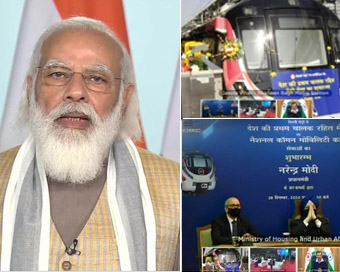Gallery
 PM Modi visit USA
PM Modi visit USA Only the mirror in my washroom and phone gallery see the crazy me : Sara Khan
Only the mirror in my washroom and phone gallery see the crazy me : Sara Khan Karnataka rain fury: Photos of flooded streets, uprooted trees
Karnataka rain fury: Photos of flooded streets, uprooted trees Cannes 2022: Deepika Padukone stuns at the French Riviera in Sabyasachi outfit
Cannes 2022: Deepika Padukone stuns at the French Riviera in Sabyasachi outfit Ranbir Kapoor And Alia Bhatt's Wedding Pics - Sealed With A Kiss
Ranbir Kapoor And Alia Bhatt's Wedding Pics - Sealed With A Kiss Oscars 2022: Every Academy Award Winner
Oscars 2022: Every Academy Award Winner Shane Warne (1969-2022): Australian cricket legend's life in pictures
Shane Warne (1969-2022): Australian cricket legend's life in pictures Photos: What Russia's invasion of Ukraine looks like on the ground
Photos: What Russia's invasion of Ukraine looks like on the ground Lata Mangeshkar (1929-2022): A pictorial tribute to the 'Nightingale of India'
Lata Mangeshkar (1929-2022): A pictorial tribute to the 'Nightingale of India' PM Modi unveils 216-feet tall Statue of Equality in Hyderabad (PHOTOS)
PM Modi unveils 216-feet tall Statue of Equality in Hyderabad (PHOTOS)India Open Competition in Shotgun, organised by the National Rifle Association of India (N
- Hockey India names Amir Ali-led 20-man team for Junior Asia Cup
- Harmanpreet Singh named FIH Player of the Year, PR Sreejesh gets best goalkeeper award
- World Boxing medallist Gaurav Bidhuri to flag off 'Delhi Against Drugs' movement on Nov 17
- U23 World Wrestling Championship: Chirag Chikkara wins gold as India end campaign with nine medals
- FIFA president Infantino confirms at least 9 African teams for the 2026 World Cup
PM Modi flags off India’s first driverless train on Delhi Metro’s Magenta Line Last Updated : 28 Dec 2020 12:52:50 PM IST 
Prime Minister Narendra Modi on Monday inaugurated India's first-ever driverless train operations on Delhi Metro's Magenta Line, along with the fully operational National Common Mobility Card service, and said that India will have the metro service in more than 25 cities by 2025, as against in 18 cities currently.
Fully automated driverless train will run on the 37-kilometre long Magenta Line from Janakpuri West to Botanical Garden. It will eliminate the possibility of human error. After the start of driverless services on the Magenta Line, the Pink Line of the Delhi Metro is expected to have driverless operations by the mid of 2021."First metro in the country was started with the efforts of Atal Ji. When our government was formed in 2014, only five cities had metro services and today 18 cities have metro rail service. By 2025, we will take this service to more than 25 cities," the Prime Minister said after virtually inaugurating the driverless metro.He further said that the country had a metro network of 248 kilometers when his government was formed in 2014, which has tripled today and will expand further to 700 kilometers by 2025. "In 2014, 17 lakh people used to travel by metro. Today, the footfall has increased by five times. This is the evidence of ease-of-living."He also inaugurated the National Common Mobility Card, which will be fully operationalised on the Airport Express Line to enable anyone carrying a RuPay-Debit Card issued from any part of the country to travel on the Airport Express Line using that card. This facility will become available on the entire Delhi Metro network by 2022."This shows that how India is fast moving towards smart system. Urbanisation should not be thought as a challenge but an opportunity, which can be used to have better infrastructure in country and increase ease-of-living," he added.Alluding to the erstwhile United Progressive Alliance government, he added, "That time, no one paid heed to the future's requirement, work used to be done half-heartedly and there was delusion. Result was such that in various parts of the country, a huge gap came in the infrastructure demand and fulfillment."The Prime Minister said that his government was able to overcome these challenges despite having the same bureaucracy and people. "How did this change come about? We thought of urbanisation not as a challenge but an opportunity. Earlier, our country did not have any policy regarding metro. Politicians and governments used to make false promises. Our government made policy and implemented it."IANS New Delhi For Latest Updates Please-
Join us on
Follow us on








172.31.16.186







